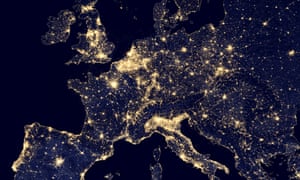https://www.theguardian.com/environment/2017/nov/23/nights-getting-brighter-but-not-in-a-good-way
The world’s nights are getting alarmingly brighter – bad news for all sorts of creatures, humans included – as light pollution encroaches on darkness almost everywhere.
Satellite observations made by researchers during five consecutive Octobers show Earth’s artificially lit outdoor area grew by 2% a year from 2012 to 2016. So did nighttime brightness.
Light pollution was even worse than that, according to the German-led team, because the sensor used cannot detect some of the LED lighting that is becoming more widespread, specifically blue light.
The observations indicate stable levels of night light in the US, the Netherlands, Spain and Italy. But light pollution is almost certainly on the rise in those countries given this elusive blue light, according to Christopher Kyba of the GFZ German research centre for geosciences and the lead author of the study published in Science Advances.
Also on the rise is the spread of light into the hinterlands and overall increased use. The findings shatter the long-held notion that more energy-efficient lighting would decrease usage on the global – or at least a national – scale.
“Honestly, I had thought and assumed and hoped that with LEDs we were turning the corner. There’s also a lot more awareness of light pollution,” Kyba told reporters by phone from Potsdam. “It is quite disappointing.”
The biological impact from surging artificial light is also significant, according to the researchers.
People’s sleep can be marred, which in turn can affect their health. The migration and reproduction of birds, fish, amphibians, insects and bats can be disrupted. Plants can have abnormally extended growing periods. And forget about seeing stars or the Milky Way if the trend continues.
About the only places with dramatic declines in night light were in areas of conflict such as Syria and Yemen, the researchers found. Australia also reported a noticeable drop, but that was because wildfires were raging early in the study. Researchers were unable to filter out the bright burning light.
Asia, Africa and South America, for the most part, saw a surge in artificial night lighting.
More and more places are installing outdoor lighting, given its low cost and the overall growth in communities’ wealth, the scientists noted. Urban sprawl is also moving towns farther out. The outskirts of major cities in developing nations were brightening quite rapidly, Kyba said.
Other especially bright hot spots included sprawling greenhouses in the Netherlands and areas of intensive agriculture.
One of the co-authors, Franz Holker of the Leibniz institute of freshwater ecology and inland fisheries in Berlin, said things were at the critical point.
“Many people are using light at night without really thinking about the cost,” Holker said. Not just the economic cost, “but also the cost that you have to pay from an ecological, environmental perspective”.
Kyba and his colleagues recommend avoiding glaring lamps whenever possible – choosing amber over so-called white LEDs – and using more efficient ways to illuminate places such as parking lots or city streets.
For example, dim, closely spaced lights tend to provide better visibility than bright lights that are more spread out.

沒有留言:
張貼留言